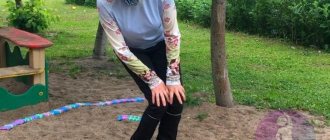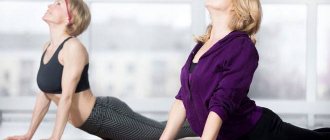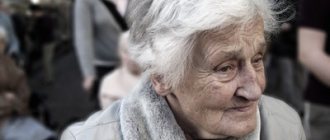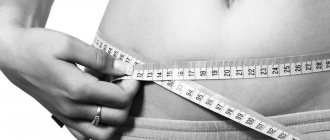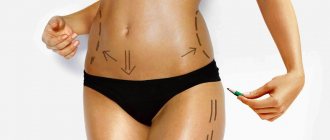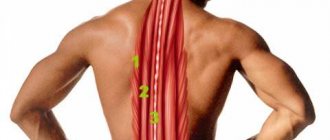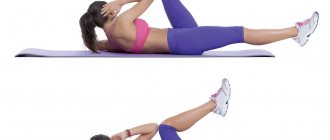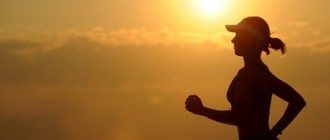11/20/2020 Physical activity is an integral part of every person’s life. This has always been the case. Even primitive people were constantly on the move and developed their physical skills to survive in harsh conditions. A lot of literature is devoted to daily exercise. Even in cartoons you can see episodes where the main characters do exercises. This allows you to get used to mandatory exercises from an early age.
The peak of physical activity usually occurs in adolescence. After reaching the age of forty, a person begins to lead a more sedate lifestyle, and by the age of fifty, as a rule, any sports activities are excluded. This has an extremely negative effect on the body and causes a number of diseases. After spending time passively, people begin to quickly get tired, muscles weaken, posture disorders and other negative consequences are observed.
Even a basic set of exercises has an extremely positive effect on the body of an elderly person. This is physiology, proven by many years of research. You can do some basic analysis. Just look at a person who led a passive lifestyle and those who played sports. At the same age, they will have completely different appearance and health status. Decreased activity provokes premature aging due to weakening muscles. It is worth noting that it is never too late to start doing exercises. Even older people can improve their well-being and look at life in a new way, thanks to a set of simple exercises.
With regular exercise, serious changes begin to occur in the body, including:
- improved blood circulation;
- improved posture;
- strengthening the nervous system;
- excess weight loss;
- normalization of metabolism;
- improving motor skills.
This is just a short list of the positive effects that proper performance of special exercises has for older people. In addition, breathing problems disappear, the immune system is strengthened, the skin becomes more elastic and chronic fatigue disappears. Such changes can radically change the life of an elderly person for the better.
It is necessary to start doing physical exercises as early as possible. The fact is that people who lead a sedentary lifestyle are more susceptible to various diseases. As a result, problems with the heart, joints, and so on may appear. A person burdened with a large number of physical problems will not be able to exercise and be active due to many contraindications. Thus, a vicious circle is obtained. You need to take care of yourself and avoid such situations. Standard exercises that don’t take much time but provide amazing results will help with this.
Even older people who are bedridden can do certain exercises under the supervision of relatives or healthcare professionals. In addition, for this category of people, exercise can be a real salvation. In everyday life, we do not notice how many different exercises we have to perform during the day. This manifests itself in trips to the store, climbing stairs, squats and other manifestations. People who are forced to spend most of their time in bed due to health conditions do not have this opportunity. Because of this, they may develop bedsores, sepsis, thrombosis and other troubles. In this case, medications are powerless. Only light exercises performed with the help of third parties can save the situation.
Some people love to dance; this type of activity is also welcome and has a beneficial effect on the body. However, in this article we will talk about standard exercises that will strengthen your muscles and restore vitality to your entire body.
Possible contraindications
There are very few contraindications for morning exercises. The fact is, this is not professional sports, where you need to be subjected to grueling loads every day, break records and meet the set time. Exercise only tones the muscles and prevents them from weakening and atrophying. When performing it, you can take breaks, as well as control the time of classes and their volume, which is selected individually. Charging is not recommended for older people in the following cases:
- severe dizziness and weakness;
- various fractures and cracks;
- acute viral diseases in the acute stage;
- bleeding and joint damage;
- increased body temperature;
- infectious diseases;
- recovery period after illnesses.
It is worth noting that in such conditions an elderly person will not be physically able to do exercises. Therefore, it is very difficult to harm your body in this way. To get more accurate recommendations, you need to consult a doctor who can professionally assess your health status and draw appropriate conclusions.
What exercises are best for an elderly person?
Exercise for older women for weight loss or other purposes must be chosen correctly. An individual approach is important, which only a qualified specialist can do. If you have serious illnesses, it is better to additionally consult with your doctor. Several principles that must be followed when creating classes:
- It is advisable to avoid very difficult exercises;
- all tasks must be accessible;
- If possible, exercise machines and special devices are allowed, but loads can be performed without them;
- it is important to work out all muscle groups to get a positive result;
- the main load is concentrated on the spine, unless there are any contraindications;
- watch your breathing, it should be smooth, exhale and inhale smoothly, deeply;
- for osteochondrosis and other diseases of the musculoskeletal system, be sure to choose activities that do not cause pain.
Exercise is not only an activity for the body, but also for the soul. Most people notice not only the benefits, but also the pleasure. There is a type 2 diabetes exercise for the elderly. In this case, the complex is selected in accordance with the patient’s condition, taking into account diet and other factors. After each lesson, be sure to pay attention to your condition. If you experience severe weakness, drowsiness, or pain, contact your instructor; you may need to change the routine.
Features of physical exercise
To achieve a positive effect, the presence of two important factors is necessary. First of all, you need to choose for an elderly person exactly those exercises that will benefit him. This will require consultation with your doctor. The second important factor is taking initiative. An elderly person should not be forced to do exercises or other physical exercises. He himself must show desire and enjoy it.
In old age, exercises should be performed under the supervision of relatives or doctors. In doing so, observers should keep the following recommendations in mind:
- If an elderly person is tired or performs exercises with great effort, the exercises must be interrupted.
- The entire process should take no more than ten to twenty minutes. There is no need to overload the human body in old age, this can lead to negative consequences.
- It is recommended to do exercises in the morning, before eating, in a well-ventilated area.
- It is necessary to carefully monitor breathing; shortness of breath and heavy strain on the heart should not be allowed.
When selecting exercises, it is important to take into account all health characteristics and damaged parts of the body. This is done to ensure that the exercise has a positive effect and does not cause pain.
UZ "Mogilev City Emergency Hospital"
Life is a precious gift, which in young and mature years a person often disposes of frivolously. As long as he has strength and health, he does not limit himself in activity, exposing the body to excessive stress. But a person gradually ages. Aging and old age are not the same thing. Aging begins relatively early and often goes unnoticed. Already from the age of 25-30, changes begin in the body; from the age of 50 they already appear noticeably.
Aging is a destructive process in the body that inevitably develops with age as a result of the increasing damaging effects of external factors and leading to a lack of physiological functions of the body. Muscle flaccidity is the first signal of the onset of aging. To maintain their tone, regular physical activity is necessary.
Old age is a period of life that is a consequence of the aging process. Age gradations for older ages: elderly - 60-74 years, senile - 75-89 years, long-lived - 90 years and older.
In general, society is “aging”: the number of older people in it is increasing. A person, as a rule, does not live to his biological age. The living conditions of modern society, especially diseases that are widespread in the second half of life - atherosclerosis, ischemic heart disease, arterial hypertension, diabetes mellitus, etc., lead to premature aging.
I.I. Mechnikov, rightfully revered as the father of Russian gerontology, said: “A long life is not valuable in itself, but only when it coincides with the preservation of physical and mental abilities.” Numerous examples of longevity and the results of scientific research give the right to believe that the limit of human life is approaching 100-120 years. What's the most beautiful thing in the world? Old head and young heart.
In the sixth decade, attitudes towards one’s own capabilities change. Acquired illnesses and problems characteristic of this particular age make themselves felt. Many people think something like this: since age-related ailments are inevitable, it is necessary to moderate your ardor and submit to circumstances. People begin to move less and take more medications, believing that in this way they save energy and help the body cope with the transition to a new lifestyle. However, such a position is a harmful misconception.
And in old age, life can be full, full of vivid sensations and events, i.e. almost as active as in previous years. It is only important to have a good idea of what physiological changes are occurring in the body at a given period of time, and in accordance with this, adjust (and not radically change!) your daily behavior style, diet, etc.
In the period “over 60”, not only a restructuring of some functions occurs in the direction of their inhibition and subsequent extinction, but a counter process is also observed: the body actively resists negative phenomena. Therefore, restrictions at this age should not be absolute, but reasonable, aimed at prolonging a vigorous and active state until old age.
Physical activity becomes of paramount importance: in organs, muscles and vessels that receive a feasible load, metabolism increases, i.e. nutrition of cells, and they stay healthy longer.
As for specific diseases of the elderly, their list is quite extensive, however, these ailments are not as fatal as is sometimes thought. Some of these diseases can be successfully prevented. Others are effectively treated with a healthy diet, a structured active lifestyle, herbal remedies and exercise. The desire of the patient himself to overcome the disease is of great importance.
Advice for elderly patients: before starting regular exercise, it is advisable to consult a physical therapist.
Science and everyday practice have proven that even moderate physical activity can slow down the aging process, improve the functioning of the cardiovascular system, respiratory system, increase muscle strength and mobility in the joints, increase bone density, and reduce susceptibility to depression.
The primary goal of health training is to increase the level of physical condition to values that guarantee safe human health.
For those who have never exercised, you need to start with a small number of exercises and their repetitions.
Principles of physical education:
1. Gradual increase in load - go “from simple to complex” and “from less to more.”
2. Constant and regular physical activity throughout the week.
3. Correct execution of movements.
Movement itself does not provide health. Only “correct movement” brings health, i.e. correct selection of a complex of physical activity, which includes strength, stretching and aerobic exercises.
Be sure to do morning exercises. Exercise is a warm-up before the working day. First, simple exercises are performed for the legs and back while lying on the bed. Then, getting out of bed, do exercises for the arms and shoulder girdle. Preferably 15-20 repetitions of each movement. Exercises should be done not only in the morning, but also in the evening to relieve fatigue.
The cardiovascular system is one of the first to respond to physical activity. The flow of blood (and oxygen) increases not only to the skeletal muscles, but also to the heart.
Metabolism in tissues increases. The positive effect of physical education on the central nervous system: increased performance, improved mood, coordination of movements.
Self-monitoring of the state of the cardiovascular system is mandatory. First, you need to measure your heart rate at rest, before performing exercises, and calculate the maximum permissible heart rate using K. Cooper's formula: 220 - age . For example, for a 60-year-old person, 220 - 60 = 160. The optimal heart rate during exercise is 80% of the maximum heart rate. For a person 60 years old - 128 beats per minute. If he raises and maintains his pulse in this mode for at least 20 minutes 4 times a week, then he gets a good aerobic (health-improving) effect.
It is also important to count your pulse during exercise and 5 minutes after completing it (a good result is a 50% reduction in heart rate).
Physical exercises should be performed in sets throughout the day. This will prevent overload of the cardiovascular system, and the training effect will be given by the total number of repetitions per day. After physical activity, muscle stretching exercises are performed.
Walking down the street is encouraged, as it is the most physiological exercise for the heart. You can always find time for walking. Don't use the elevator, take the stairs, walk to work. It is important to remember that walking must be fast, only then will it have a training effect. But for people with diseases of the leg joints, long walking and squats are not recommended. They are shown special exercises for the legs while sitting and lying down.
Exercise now, today! Don’t put it off for old age, for retirement, when “time appears”, but at the same time your health suddenly disappears! (S.M. Bubnovsky).
Your physical therapy doctor
I.Yu.Isaeva
Where to start charging
First of all, you need to remember that the health of an elderly person and the reserve of strength are much weaker than in adolescence. Therefore, it is important not to harm and control the functioning of all body systems. Particular attention should be paid to breathing and heartbeat.
In order for the body to gradually warm up and not experience sudden stress, you should start charging with a light warm-up. The best option is walking. If the room is too small, walking in place is allowed. After this, you can move on to bending and so on. In the first days, it is enough to limit yourself to one type of exercise to prevent muscle fatigue and the appearance of microcracks. The number of repetitions can be increased every day. Periodically you need to take breaks to rest and monitor your heart rate. If your health condition worsens, you need to limit physical activity.
Official website of the State Budgetary Institution TCSO "Yuzhnoportovy" Social service provider
Recently, you can see more and more older people playing sports. They go to gyms, run, and practice Nordic walking. And this is a very good trend, because, you see, it is better to play sports, improve your health and spend time actively than to sit on a bench under the entrance and complain about numerous health problems. Of course, no one demands Olympic records from people over 60, but moderate physical activity will only bring benefits. Even simple exercise for older people over 60 years old is already a worthy contribution to maintaining health and active aging. At the Lefortovo State Budgetary Institution, after a short break, breathing exercises resumed.
About the benefits of exercise for older people
Physical activity should be an integral part of a person’s life, and its absence provokes many troubles. Once you reach a certain age, sports become less of a part of most people's lives. Over time, a person loses tone and vigor, becomes slower and clumsier. Of course, everything can be attributed to banal old age. But it's not only that. Due to lack of movement, muscles, joints and ligaments become weaker. The nervous system also weakens without physical activity, making it less able to control movements. Older people are characterized by a stooped, shuffling gait.
Exercise for those over 60 will help improve the quality of life and prolong it, improve health in general. No pill will provide as many benefits as physical activity. Regular exercise helps strengthen the nervous system and blood vessels, improves heart function, maintains posture and gait, fights excess weight, improves metabolism and gives vitality.
Exercise improves breathing and blood circulation, strengthens the immune system, and reduces the risks of many age-related diseases. It fights the weakening of inactive muscles, thereby preventing their atrophy. A sedentary lifestyle is the cause of a large number of diseases. People over 60, who already have many ailments, most often, in principle, do not think about any physical activity, quietly suffering from age-related changes. And we get a kind of vicious circle: due to immobility, the state of health worsens, and due to deteriorating health, the level of physical activity decreases. Immobility can cause the development of thrombosis, sepsis and a number of other problems.
To summarize all that has been said, let us highlight the main advantages of charging for elderly people over 60 years of age:
- keeps the nervous system in good shape; - improves metabolism, which slows down greatly over the years; - strengthens the heart and blood vessels, improves the respiratory system; — improves the quality of motor activity; - prevents the development of osteoporosis; - fights constipation, venous thrombosis; - improves immunity; - maintains mental clarity; - Provides a boost of energy and good mood.
Come study with us - we are glad to see you!
Lefortovo branch address: Gospitalnaya, building 6 tel. :8-499-763-38-98
Several exercises for older people
There are a huge number of types of morning exercises, and most of them are well suited for older people. All exercises are aimed at a specific muscle group and allow you to achieve different results. In addition, they differ in purpose and allow you to normalize your health: eliminate problems with constipation, normalize blood circulation, strengthen joints and muscles. This block will discuss general strengthening exercises that affect the entire body.
- "Toe to toe"
You will need a chair for this exercise. You need to sit down with your back straight. The exercise is performed in counts of up to four. At one time, the left leg is crossed over the right. On two feet the leg returns to its original position. After this, for three or four, similar actions are performed with the right leg.
- "Dragonfly"
The exercise must be done on all fours. First, the left hand is extended to the left side, after which it returns to its original position. Next, do the same with the right hand. While performing it, it is important to monitor your balance so as not to fall and get injured.
- "Wings"
We sit on a chair and put our hands on our knees. At one time we spread our arms to the sides and raise them up. On two we return to the starting position. At three we bend forward. You can do up to five repetitions.
- "Rotation"
We clench our hands into fists and begin to rotate our wrists, first in one direction four times, then in the other. Exercise develops joints well and prevents salt deposits.
- "Shoulder Rotation"
We place our feet shoulder-width apart and take a stable position. We place our hands on our shoulders and begin slow rotations, first in one direction, then in the other. Thus, the muscles of the back and shoulders are strengthened.
- "Letter T"
We sit on a stable chair, straighten our back and place our hands on our knees. Next, we raise our hands to our shoulders and spread them apart, forming the letter “T”. After this, we return our hands to our knees and repeat the exercise several times.
- "Dog"
We take a position on all fours, resting our palms firmly on the floor. On count one, we bend the spine to the right, on count two, we bend it to the left. This exercise is contraindicated for older people with a back injury.
- "Star"
You need to lie on your back, straighten your legs, while your arms lie along your body. At one time, we move our left arm and right leg to the sides. On two - we return to the starting position. At three, we move our right arm and left leg to the side.
These exercises can be combined, selecting the optimal number of repetitions and rest breaks. The complex of physical activity should correspond to the testimony of specialists and personal preferences.
- Exercises with a stick
When charging, additional items are often used. Below we will look at a number of useful exercises with a stick.
- "Lever arm"
We sit down on a chair. One end of the stick rests on the floor and is compressed by the feet, the other end is fixed with the palms. Leaning your hands on the stick, bend forward, while trying to straighten your back as much as possible. On the count of two, we slowly return to the starting position. You can do up to six repetitions. Older adults may need help with this exercise.
- "Rolling pin"
This exercise can be performed either standing or sitting. The stick is fixed with the elbows behind the back and slowly rolls along it. The exercise significantly improves posture and strengthens the back muscles.
Classic exercise on video
Classic exercises include the most common exercises that have a general strengthening effect on the body. To make it more interesting for an elderly person to perform all the actions and not have to memorize complex movements, it is recommended to perform the exercises before the educational video clip.
You need to select a high-quality video in which the instructor clearly shows and explains how to perform this or that movement. It is important that all movements in the video are performed correctly. Otherwise, you can cause harm to your health and even get injured.
It is worth noting that you should not chase the video. It is important to catch the pace at which charging will be enjoyable and not difficult. You can skip a few approaches, this is not critical. In addition, if you are tired, you need to take a break to rest.
Which coronavirus vaccine is best for older people?
An elderly person, who may have a history of several dozen diseases over the years of his life, has a weakened immune system. Because of this, the body’s response to the introduction of the virus is worse, which not only complicates the course of the disease itself, but also increases the risk of developing serious life-threatening complications and increases the mortality rate among the elderly.
Therefore, increased attention is paid to immunization of pensioners in Russia. To date, vaccination is carried out using 3 Russian means:
- Sputnik V. The vaccine is administered in two stages, the time interval between which is 3 weeks. The main advantage of Sputnik V is 100% protection of vaccinated people from severe disease.
- EpiVacCorona. A peptide vaccine that has high immunological effectiveness. According to clinical studies, an elderly person will have immunity for 1 year.
- CoviVac is a drug registered in Russia on February 20, 2021. The main component of the vaccine is the inactivated (“killed”) SARS-CoV-2 virus. It is a classic type of vaccine that has been used to immunize the population for many years. Administration is carried out intramuscularly 2 times every 14 days.
Exercise for joints
Joint problems in older people are a fairly common problem. It significantly restricts movement, causes pain and worsens the quality of life. To relieve unpleasant symptoms, you must perform the following exercises:
- Head tilts forward, backward, right and left;
- Circular movements of the head. Four times in one direction, then in the other;
- Extension and flexion of the palms, as well as smooth massaging of each phalanx of the fingers;
- Stretching your arms out in front of you. It is required to straighten the elbow joint as much as possible. After several days of exercise, you will notice the effect.
- Rotating movements of the feet and hands.
- Bend your knees; with sufficient physical fitness, you can do squats.
Don't rush things and try to achieve the effect in one day. All exercises with joints must be performed smoothly and carefully. If you have complaints about pain, you can reduce the number of approaches and duration of exercise.
Exercise for constipation
Constipation is a common problem for older adults. There are many ways to get rid of this trouble, but they all have significant drawbacks. For example, taking medications can have a detrimental effect on your general condition. Diets are quite exhausting, especially since the body stops receiving all the nutrients. The best solution is to perform special exercises. The most effective of them are:
- Lying on your back, you need to tuck your knees. You can put your hands under your head. Next, while inhaling, bend your knees to the right. We return to the starting position as we exhale. After this, we make a similar tilt to the left.
- Lie on your back and make slight turns with your hips. You need to relax your whole body as much as possible.
- Standing on your knees, we begin to make circular turns, first in one direction, while trying to reach the heel with your hand. Then turn in the other direction. The exercise can be repeated up to ten times.
At first, you need to repeat these steps daily. Once the problem is resolved, two classes per week will be sufficient.
